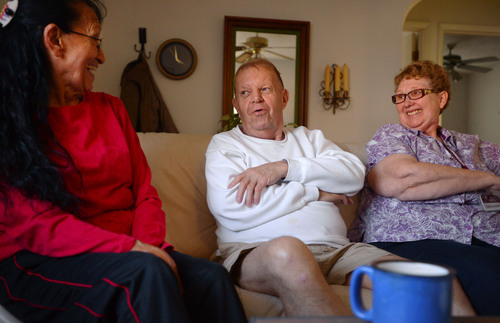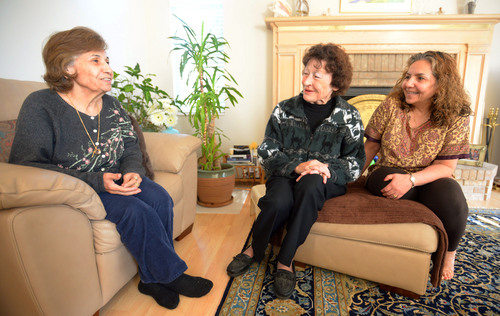This is an archived article that was published on sltrib.com in 2013, and information in the article may be outdated. It is provided only for personal research purposes and may not be reprinted.
After Paul Murray lost everything, his life began careening into silence and loneliness.
Murray, 73, lives in a whitewashed brick home, tucked into a narrow side street in Magna. His living room is impeccably arranged — a playground for George, the temperamental rescued alley cat, and a predictable environment for a man who is nearly deaf and almost blind. Murray has lived in the home since the mid 2000s, he said, when he lost everything to identity fraud and moved to Utah from Las Vegas. When he arrived, Murray had few resources, failing health and almost no contacts.
"I simply had nobody," he recalled.
But Murray's life in Magna didn't turn out particularly bleak, and that's mostly due to Salt Lake County Aging Services' Senior Companion Program.
The program offers seniors such as Murray — who live on their own or with family — companionship and assistance in an effort to help them stay active and independent. The companions themselves are also seniors — people over the age of 55 who live on a limited income and want to help. It's a volunteer position with minimal reimbursement, but for people like Murray, it's also the difference between freedom and a life of decline and marginalization.
—
The senior companions • About 19 months ago, Colleen Johnson received a call from a Senior Companion Program coordinator. The coordinator wanted to know if Johnson, a 62-year-old companion, would visit a man. She said she would. The coordinator then said the man was blind. Not a big deal, Johnson replied.
The two went back and forth with a series of questions until finally Johnson had agreed to serve as a companion to Murray. The initial visit was about two-and-a-half hours long, Johnson recalled, and now she stops by twice a week to take Murray grocery shopping, write checks and do other things his deteriorating eyesight makes impossible.
Murray and Johnson's relationship is typical for the Senior Companion Program; coordinators try to pair compatible people together, taking into account things like driving distance and personal preferences.
But their relationship also shows how the program can blossom into something that looks more like friendship than run-of-the-mill service. On a chilly November afternoon, the two sat close together on Murray's cream-colored sofa, chatting amiably. Murray struggled to hear the other people in the room, but Johnson leaned in close to his ear and repeated the parts of the conversation he missed. His face lit up with comprehension as he listened to Johnson.
"I couldn't get by without Colleen," Murray said several minutes later as George the cat curled up between their feet. "It takes a special person to work with older people."
Rose Martinez, 80, is another one of those people, and also visits Murray twice a week. She said Murray "is always talking" during her visits, which she enjoys as she drives him around town to do errands. Martinez visits two other people and said she likes the program because it keeps them out of nursing homes. It also helps her feel like she's contributing.
"To me, helping people fills my own void," Martinez said. "If I had a big enough house I would gather all of these people there."
—
A way to give back • Dwight Rasmussen — the program manager and acting director of Salt Lake County Aging Services — described Martinez's and Johnson's work as a cost-effective way to ensure that seniors continue living pleasant lives as they age. The program currently has 85 volunteers serving 226 people. There are another 191 people on a waiting list, hoping to have a senior companion in the future.
In order to qualify, prospective senior companions have to make less than $1,915 per month for a household of one, or $2,585 for a household of two. They are asked to serve 20 hours a week and have to pass a criminal background check.
People not fitting the income requirements can participate in other programs, Rasmussen said.
The Senior Companions Program doesn't pay volunteers. However, Rasmussen said the companions get a $2.65 per hour stipend and some limited transportation and meal reimbursements. The program is paid for by government grants and costs at most $4,000 per year for a companion.
There is no cost to the people receiving visits. And according to Rasmussen, the program offers a way for both companions and clients to remain connected to the outside world.
"It gives them an opportunity to stay involved or stay active," he added. "They're giving back."
—
A way to respite • Three years ago Luba Adams had a stroke. Adams was living in Texas at the time, but in the aftermath lost some of her ability to take care of herself. Her daughter, Rossana Rasekhi, who lives in Sandy, picked up the slack.
"I took legal guardianship," Rasekhi explained. "We brought her here."
Adams is now 80 years old and still lives with Rasekhi and her husband. It's an arrangement that works for the family, in large part due to a another aspect of the Senior Companions Program: respite care.
Adams now receives visits from Kathy Foster, 70, who stops by three days a week to go out for lunch or drive to church. It's a welcomed connect to the outside world for both women.
"I like people," Foster said. "I always have."
But unlike the companions' visits to Murray, Foster's job also has an important second role: giving Rasekhi a break.
Rasmussen said that people caring for elderly relatives sometimes can't get a break. As a result, they run the risk of becoming overwhelmed or suffering deteriorating health. The relentlessness of elder care isn't something that a lot of people think about before they experience it, but Rasmussen said it's a big deal.
"Research has shown if people don't have a regular break, they just give up," he explained.
Rasekhi is getting those much-needed breaks, which she uses to exercise or go skiing in the nearby mountains, and it makes a huge difference. She said that if she didn't have Foster — who she called an "angel" — she would have to pay someone to sit with Adams or, worse, put her in a home. Neither of those options was acceptable to Rasekhi, she said, because the options are too expensive and because she worries about the quality of the care Adams would receive.
"I could not live with myself putting my mother in a nursing home," she added.
Thanks to Foster and the Senior Companions Program, Rasekhi isn't faced with that future.
Rasmussen said The Senior Companions Program is always looking for more volunteers and support. To find out more or to participate, visit the Salt Lake County Aging Services website or call 385-468-3259.
Twitter: @jimmycdii







